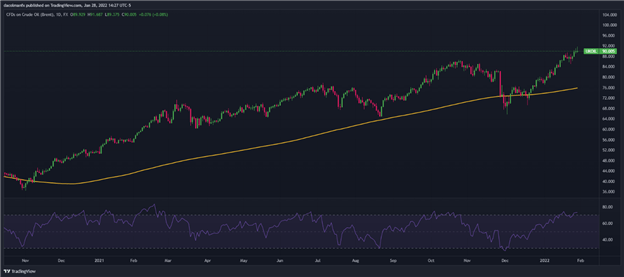WTI OIL WEEKLY FORECAST: CAUTIOUSLY BULLISH
- Crude oil has risen aggressively in recent weeks amid supply and demand imbalances. Since its December low, WTI is up about 42%, while Brent has jumped roughly 39%
- Under normal circumstances, an overextended rally could lead to a reversal, but rising geopolitical tensions in Eastern Europe may prevent this outcome for the time being
- If Russia invades Ukraine, we may see an explosive upside move in energy markets
Most read: Crude Oil Price Forecast – Fresh Highs Suggest Buying Dips
Oil prices have risen sharply over the past two months amid supply and demand imbalances, at a time when consumption is expected to return to pre-COVID-19 levels later this year. While OPEC+ has been gradually unwinding the record cuts agreed at the start of the pandemic, many cartel members have struggled to increase output and meet production targets amid capacity constraints. Against this backdrop, Brent has surged roughly 39%, while the WTI blend has climbed more than 42% from the December lows.
With Brent above $90 per barrel for the first time since 2014 and somewhat overbought (see RSI indicator below), many traders expect to see selling activity from a sense of accomplishment and profit taking from speculators, but acknowledge any decline will be transitory in nature as the underlying and fundamental backdrop remains constructive for the commodity.
Although a technical pullback is possible after an overextended rally, there are some variables that may complicate this scenario and, in fact, create upside risks. One of them is the crisis in Eastern Europe, stemming from the increasing likelihood that Russia will invade Ukraine. Although Moscow has denied that it has plans to launch an incursion despite amassing more than 120,000 troops and combat equipment on its neighboring country’s borders, NATO and the United States are convinced that President Putin will give the order to attack soon, perhaps within weeks.
A military escalation in the region could lead to a serious disruption in energy supplies, especially if the White House imposes tough sanctions on Russia, the world’s second largest oil producer and a key provider of natural gas to Europe.
At this time, it is all speculation, but Wall Street fears that Putin could reduce crude exports, or more likely, cut off gas deliveries to the West should his country become the target of far-reaching economic warcraft from the U.S. and its allies (SWIFT system exclusion, for example).The European Union relies on Russia for roughly 35% of its natural gas, so any disruptions to flows during the depth of winter, when demand is the highest, could spark an energy market crisis, triggering a furious rally in the space.
Any surge in natural gas prices could create more incentives for fuel substitution, boosting oil demand and pushing the market further into deficit. This bodes well for both WTI and Brent, but not so much for the global economy as higher prices may weaken the recovery.
In summary, crude oil maintains a bullish outlook over the medium term. In the short term, oil is likely to remain supported if geopolitical tensions in Eastern Europe continue to increase, but if they abate, buying momentum could moderate temporarily as risk premium falls. In the event of military conflict, that is if Russia invades Ukraine, all bets are off. The latter scenario could pave the way for a violent rally in oil prices. Putin is expected to make a decision soon, so traders should keep a close eye on the situation to avoid getting caught on the wrong side of the trade.
WTI CRUDE OIL PRICES
Brent Crude Oil chart prepared using TradingView
EDUCATION TOOLS FOR TRADERS
- Are you just getting started? Download the beginners’ guide for FX traders
- Would you like to know more about your trading personality? Take the DailyFX quiz and find out
- IG’s client positioning data provides valuable information on market sentiment. Get your free guide on how to use this powerful trading indicator here.
—Written by Diego Colman, Market Strategist & Contributor



Be the first to comment